
|
|
ANNUAL: A standard 12-month period, or one year, used for reporting economic and financial data. Gross Domestic Product and related measures are noted economic data released annually. Many businesses also provide annual financial reports. Another standard reporting period is the quarter.
Visit the GLOSS*arama
|
|


|

|
                           FEDERAL RESERVE SYSTEM: The central banking authority of the United States that is charged with conducting monetary policy and regulating the commercial banking system. It includes a Board of Governors, 12 District Banks, 25 Branch Banks, and assorted committees. The most important of these committees is the Federal Open Market Committee, which directs monetary policy. The Fed (as many like to call it) was established in 1913 and modified significantly during the Great Depression of the 1930s. Its duties are to maintain the stability of the banking system, regulate banks, and oversee the nation's money supply. The Chairman of the Federal Reserve System is one of the most important and powerful positions in the economy. The Federal Reserve System (or Fed) is the central banking authority of the United States. The places the Fed at center stage in the control of the money supply, the conduct of monetary policy, and the regulation of the commercial banking system. A primary task of the Fed is to manipulate the total quantity of money in circulation with the goal of stabilizing business-cycle fluctuations, and subsequently keeping both unemployment and inflation in check. It pursues this task primarily through open market operations, the buying and selling of U.S. Treasury Securities through the open market.The Fed is also one of the principal government regulators of the commercial banking system (along with the Federal Deposit Insurance Corporation and the Comptroller of the Currency). Regulatory oversight by the Fed is used both to control the money supply and to ensure the banking system is fundamentally sound, thus avoiding economy-wide financial problems such as what occurred during the Great Depression of the 1930s. The central role played by the Federal Reserve System in the economy makes the Chairman of the Board of Governors one of THE most important decision-makers in the economy. The Chairman sets the philosophical tone for the course of monetary policy and can have a profound impact on the overall performance of the macroeconomy. A Little HistoryThe Federal Reserve System was established in 1913 in direct response to a widespread economic and financial downturn known as the Bank Panic of 1907. After several decades of economic and financial instability, political leaders decided that a central banking authority charged with stabilizing the banking system was needed. However, the Federal Reserve System was not the first attempt at central banking in the United States. - First Bank of the United States: The founding fathers--the guys behind the Declaration of Independence, Revolutionary War, and Constitution--also established the Bank of the United States in 1791, the first central bank of the United States. Alexander Hamilton, the first Secretary of the Treasury and the face on the $10 bill, was also a chief proponent of this central bank. This First Bank of the United States was just what the fledgling country needed to get its financial house in order. And it worked... for a while. Its charter, however, expired in 1811 and was not renewed.
- Second Bank of the United States: Motivated by the same desire to have central banking oversight that motivated the first bank, a Second Bank of the United States was formed in 1816. The Second Bank of the United States experienced a great deal of controversy during its brief existence. In 1832, its demise was sealed when President Andrew Jackson, a major critic of federally controlled central banking, vetoed a bill renewing the charter of the second bank. The charter officially expired and the bank ceased to operate in 1836.
From 1836 to 1913, the United States had NO federally sanctioned central bank. This eight-decade period was also marked by perpetual economic turmoil. Just coincidence? Probably not. During this period, economic downturns were typically termed "bank panics," rather than business-cycle recessions. Banking instability was, more often than not, the cause of economic problems.Banking instability often led to economic downturns because the lack of central bank regulatory oversight encouraged some banks played fast and loose with deposits and loans. With no central bank providing emergency reserves, banks that played it too fast or too loose, often came up short of reserves and were forced to shut down. When these banks closed down any deposits evaporated and so too did financial wealth and part of the money supply. Such bank failures were seldom isolated events. The failure of one bank often caused a chain reaction throughout the banking system, causing other banks to fail as well. Much like a tiny spark igniting a raging fire, pre-Fed panics often spread rapidly throughout the economy, causing banks to close and the money supply to shrink. Without money, production went unsold and resources were unemployed. After decades of this turmoil, the Bank Panic of 1907 was the last straw for government leaders. They decided to give central banking another try. It took a few years, but come 1913, the Federal Reserve System was established. While the Fed has not been a perfect central bank, while it has made mistakes (such as the Great Depression of the 1930s), it has generally helped to stabilize the economy, especially in recent years. The Fed Pyramid| The Fed Pyramid | 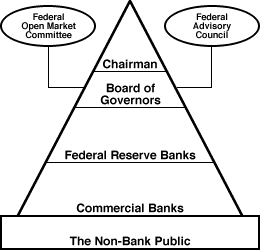 |
The structure of the Federal Reserve System is commonly depicted as a pyramid. The graph to the right provides a pictorial overview of this Fed pyramid. For a little insight into the structure of the Federal Reserve System, consider a few the numbers. Use the mouse arrow to highlight the assorted components of the Fed pyramid.- 1: At the very, VERY top of this pyramid is the Chairman of the Board of Governors, the one person who runs the show, who has the power, who calls the shots.
- 7: At the very top of this pyramid is the Board of Governors, consisting of 7 folks (including the Chairman), usually economists by training, who make the big decisions.
- 37: The middle of the pyramid is occupied by Federal Reserve Banks. These 37 banks dispersed throughout the country, include 12 District Banks and 25 Branch Banks interact directly with commercial banks and are primarily responsible for carrying out the actions of the Fed.
- 20,000: At the bottom of the pyramid are the economy's commercial banks, including traditional banks, savings and loan associations, credit unions, and mutual savings banks. While the number changes over time from mergers, closings, new start-ups and the like, the total number of establishments is in the range of about 20,000.
- 300 Million: Beneath the pyramid, the foundation upon which the pyramid is built, is the public, the non-bank public to be precise. This includes people, businesses, and even government agencies that make use of commercial banking services.
- 2 Times 12: Note the two ovals to the side of the pyramid. Each oval is comprised of 12 members. The 12 residing in the oval labeled Federal Open Market Committee are critical to the Federal Reserve's money-supply control. The 12 occupying the other oval labeled Federal Advisory Council are not quite as important, but still worth noting.
Board Of Governors| Board Of Governors | 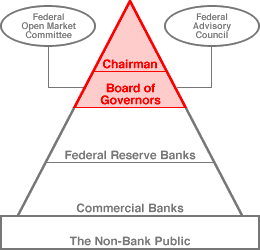 |
At the top of the Fed pyramid is the Board of Governors. The Board of Governors is the policy making body of the Federal Reserve System. They set the regulations, rules, and policies affecting the money supply and the commercial banking system. The Board of Governors is comprised of 7 members who are appointed by the President and approved by the Senate. The composition and structure of the Board of Governors is designed, like the rest of the Federal Reserve System, for independence from the President and Congress. The job of the Fed is to carry out policies deemed best for the economy; policies that might not necessarily be to the liking of the President or Congress. This independence is helped by appointing Governors to staggered terms. - Each member of the Board, like any other federal appointees, is appointed by the President and approved by the Senate. Each of the 7 governors is appointed to a 14-year term, with terms staggered every two years. In other words, one term is filled this year, another in two years, and another two years after that. After 14 years, the first term comes up for appointment again.
- This system of staggered terms is designed to keep the President from appointing the entire Board. The Board is NOT suppose to work for the President or carry out Presidential policies. With staggered, 14-year terms, a president can normally appoint no more than 3 Governors during an 8-year stay in office, preventing the appointees of the sitting President from having a voting majority.
In addition to staggered 14 year terms, appoint of the Board involves several general criteria:- First, no two members can be from the same Federal Reserve District. This ensures that 7 of the 12 Federal Reserve Districts are represented on the Board.
- Second, no member can serve two complete terms. In general, a member is appointed to serve a single 14-year term. However, this criterion allows a member to finish out a the remaining years of a term vacated by a predecessor then serve one complete 14-year term.
- Third, in addition to dispersion across districts, the composition of the Board of Governors is further constructed to represent the geographic divisions of the country.
- Fourth, the composition of the Board of Governors also is constructed to represent the varied interests of the country--financial, agricultural, industrial, and commercial. This is intended to prevent the board from containing ONLY members with experience in the financial industry.
Chairman| Chairman | 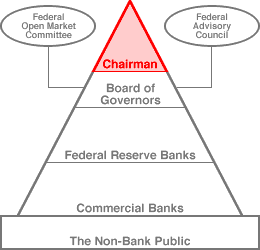 |
At the very, VERY top of the Fed pyramid is the Chairman of the Board of Governors. The Chairman of the Board of Governors is the head of the Board of Governors and thus the head of the Federal Reserve System as well. The Chairman is one of the most powerful, if not THE most powerful individuals in the economy. He (the Chairman need not be a male, but historically has been) directs monetary policy and sets the course the Federal Reserve activities. He is the main man, the guy in charge. When the Chairman speaks business leaders, political leaders, and the public take notice. Consider these tidbits of information about the Chairman. - The Chairman is appointed to a 4-year term, using the Presidential appointment, Senate confirmation process. While the 4-year term of the Chairman is the same length of the 4-year presidential term, most presidents tend to inherit the Chairman appointed by a predecessor.
- While it might go without saying, the Chairman is also one of the 7 governors serving a regular 14-year term.
- When the Federal Reserve System was created, the Chairman was little more than a figure head, the guy with the gavel who presided over Board meetings. (The actual power rested with the President of the New York Federal Reserve Bank.) However, the Chairman is now one of the most powerful economic positions in the United States and even the world. The wishes and policies of the Chairman need not be approved by the rest of the Board, but they typically are.
Federal Open Market Committee| Federal Open Market Committee | 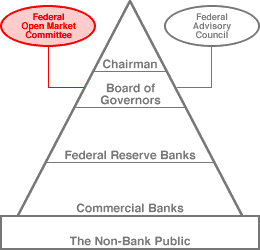 |
Emerging from the top of the Fed pyramid, an offshoot of the Board of Governors, is the Federal Open Market Committee, the key component of the Fed when it comes to monetary policy. The Federal Open Market Committee (FOMC) is a standing committee of the Federal Reserve System that is specifically charged with conducting open market operations and is more generally responsible for guiding monetary policy. The critical decisions affecting monetary policy emerge from the FOMC. The importance of this committee is reflected by its composition. - The 7 members of the Board of Governors, including the Chairman, form the core of the Federal Open Market Committee. The Chairman of the Board of Governors is also the Chairman of the Federal Open Market Committee.
- The 7 governors are joined by 5 additional members. These 5 interlopers are Presidents of Federal Reserve District Banks. The details on Federal Reserve District Banks is provided below, but for now just note that the Fed has 12 District Banks.
- At any given time, the Presidents of 5 of the 12 District Banks serve as members of the FOMC. But which 5? The selection is not a random process. It is not a popularity contest. It is not even based on merit. It uses a well-established system.
- The President of the New York Federal Reserve Bank is always on this committee. The reason for permanent membership is that the Fed's monetary policies are conducted through financial markets centered in New York City. Being in the middle of the action, the New York Federal Reserve Bank is charged with carrying out specific policy actions.
- The remaining 4 slots are shared and rotated among the remaining 11 District Banks. One slot is shared by Boston and Philadelphia. Another is shared by Dallas, Atlanta, and Kansas City. A third by Cleveland, Chicago, and Richmond. And the fourth by San Francisco, Minneapolis, and St. Louis.
- The 7 + 1 + 4 composition keeps the bulk of authority and power in the hands of the Board of Governors and the Chairman (the 7), while at the same time maintaining a channel for implementing monetary policy through the New York Federal Reserve Bank (the 1), as well as providing a decentralized nationwide input from the rest of the country through other Federal Reserve District Banks (the 4).
Federal Advisory Council| Federal Advisory Council | 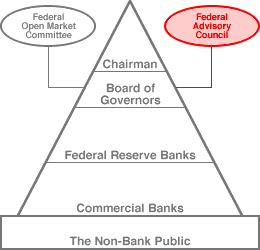 |
A second, less powerful, less important group hovering near the top of the pyramid is the Federal Advisory Council. As the name suggests, this council has no official policy making role, but is charged only with offering advice to the Federal Reserve Board of Governors. The Federal Advisory Council (FAC) consists of the Presidents from 12 commercial banks, one from each of the 12 Federal Reserve Districts.Consider these tidbits about the Federal Advisory Council: - The FAC includes 12 commercial bank presidents, one from each of the 12 Fed districts. These commercial bank presidents reach the council through selection by their friendly neighborhood Federal Reserve District Bank.
- The FAC is totally advisory. It does not set policy. It does not impose regulations. All it does is offer advice to the Board of Governors. The main function of the FAC is to provide feedback from commercial banks, and presumably their customers, about Fed policies.
- The main reason the FAC is noted here, other than for sake of completeness, is to emphasize the decentralized nature of the Federal Reserve System. This is one of many features of the Fed designed to prevent the financial "powers that be" in New York City and the government leaders in Washington, D.C. from pursuing policies with limited regard for the rest of the country.
Federal Reserve Banks| Federal Reserve Banks | 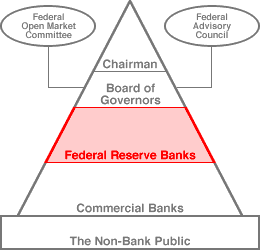 |
Dropping down a notch from the lofty position of the Board of Governors and the even loftier Chairman, down to the middle of the pyramid, is the 37 Federal Reserve Banks. Federal Reserve Banks include 12 District Banks and 25 Branch Banks that are largely responsible for supervising, regulating, and interacting with commercial banks and carrying out the policies established by the Federal Reserve Board of Governors. Federal Reserve Banks perform several key functions for the banking system and the economy. - First, Federal Reserve Banks provide banking services for commercial banks. While Duncan Thurly, a regular human being, can go to OmniBank in downtown Shady Valley to keep deposits safe or get a loan, where does OmniBank go for banking services? It can turn to Federal Reserve Banks for banking services.
- Second, Federal Reserve Banks provide regulatory oversight of commercial banks. They track the assets, liabilities, loans, deposits, and reserves of commercial banks to ensure that Federal Reserve regulations are followed.
- Third, Federal Reserve Banks process checks for commercial banks. Any given bank receives checks written on thousands of other banks. Processing these checks separately would be astronomically time consuming at best. Using reserves deposited by commercial banks (Federal Reserve deposits), the Fed offers a clearing house that streamlines this process.
- Fourth, Federal Reserve Banks are the portal for getting currency into circulation. Newly printed currency is sent to the Federal Reserve Banks, which then send the currency to commercial banks. Until the late 1990s, Federal Reserve Banks also authorized the printing of currency, with each bill indicating the issuing District Bank. For example, Boston is district 1 (or A) and San Francisco is district 12 (or L). However, the Fed began redesigning currency in the 1990s, starting with $100 bills, and dropping the district designation in the process.
- Fifth, Federal Reserve Banks are responsible for monitoring their district economies. They collect data, do studies, and hold seminars. In fact, economists at some Federal Reserve Banks have developed important advances in economic theories over the years.
- Sixth, Federal Reserve Banks offer a few limited services to the public. While Duncan Thurly cannot waltz into his local Federal Reserve Bank for a loan or checking account, he can waltz into this Fed Bank to buy savings bonds, bid for U.S. Treasury securities, or exchange U.S. currency for foreign currency.
Federal Reserve Districts| Federal Reserve Districts | 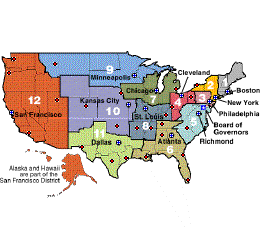 |
The Federal Reserve System is divided into 12 districts, each headed by a Federal Reserve District Bank. The configuration of the United States into these 12 districts resulted for a couple of reasons:- One, the guiding philosophy behind the formation of the Federal Reserve System in the early 1900s was a decentralized central bank. The creators did NOT want a central bank located exclusively in New York City or Washington, D.C. Hence the system contains, not just one bank, but twelve banks (plus 25 branch banks).
- Two, when the Federal Reserve System was established in the early 1900s communication and transportation systems were slower and less efficient than today. To extend assistance to, and control over, ALL banks in the economy, the Federal Reserve System had to have facilities dispersed throughout the country.
The configuration of the Federal Reserve Districts is presented in this nice little map of the U.S. of A. - A total of 37 Federal Reserve Banks are pinpointed. Each of the 12 color-coded Districts has its very own Federal Reserve District Bank. There is one in Boston and another in San Francisco. Chicago has one and so too does Atlanta.
- Several other cities marked on the map, 25 in total, are the homes of Federal Reserve Branch Banks. Some Districts have several Branch Banks, others have none. The original need for Branch Banks, (circa 1913), was to ensure regulatory oversight of ALL banks, including those in the middle of nowhere, like Wyoming or Oklahoma.
- Interesting that Missouri is the only state with two District Banks, one in Kansas City and one in St. Louis. Most District cities are also home to major league sports teams--baseball, football, and basketball. Richmond is the only district lacking in this category. The reason is that cities big enough for professional sports also tend to be financial centers.
- Of some curiosity, San Francisco, rather than Los Angeles, has the District Bank for District 12. While this might seem peculiar, San Francisco was significantly more important than Los Angeles in 1913 when the Federal Reserve System was established. Had the Fed been established in more recent times, Los Angeles might very well be the home of a District Bank.
Monetary PolicyA primary activity of the Federal Reserve System is monetary policy. Monetary policy is controlling the quantity of money in circulation to stabilize the business cycle and to reduce the problems of unemployment and inflation. Modern monetary policy is undertaken by controlling the money creation process performed through the magic of fractional-reserve banking. The Federal Reserve System has three key tools that it can, in principle, use to control money creation. - Open Market Operations: The Fed buys and sells U.S. Treasury securities through what is termed the open market. Such buying and selling affects the amount of excess reserves that banks have available to make loans and create money. This is the primary monetary policy tool used by the Fed.
- Discount Rate: The Fed can also adjust the interest rate that it charges banks for borrowing reserves. Higher or lower rates affect the amount of excess reserves that banks have available to make loans and create money.
- Reserve Requirements: The Fed can further adjust the proportion of reserves that banks must keep to back outstanding deposits (the reserve ratio). Higher and lower rates affect the deposit multiplier and the amount of deposits banks can create with a given amount of reserves. This tool is seldom used as a means of controlling the money supply.
The Federal Reserve System largely stumbled onto monetary policy through the failure of thousands of banks during the Great Depression of the 1930s. Policy makers recognized that a decline in reserves caused a drop in the money supply and reduced economic activity. If so, then an increase in reserves would then induce an increase in the money supply and a stimulation of economic activity.In the decades following the Great Depression, the Fed reacted to business-cycle instability, using monetary policy to "fix" the problems of inflation and unemployment by dampening a runaway expansion or counteracting a contraction. The Federal Reserve System of modern days has tended to be more proactive, than reactive. It generally tries to adjust the money supply BEFORE business cycle ups and downs occur, not AFTER. The Fed has not always been so forward thinking. In fact, modern monetary policy was not widely recognized as an option during the Fed's first few decades of existence. The Fed's early efforts were aimed at keeping banks in business and avoiding the serious reductions in bank reserves that would shrink financial wealth and the money supply. However, when the Fed realized it could avoid a decrease in the money supply by maintaining bank reserves, it also realized that it could manipulate the money supply by manipulating bank reserves. This moved the Fed from reactive to proactive monetary policy. Politics: Two ViewsPolitics are never far from economics, especially when policies are involved. Such is the case for monetary policies of the Federal Reserve System. Consider these two pairs of concepts:The first pair is monetary policies--expansionary and contractionary. - Expansionary monetary policy is designed to close a recessionary gap and to expand the economy out of a business-cycle contraction. The most obvious consequence is to reduce the unemployment rate. However, should the resulting stimulation get out of hand, increased inflation could result.
- Contractionary monetary policy is designed to close an inflationary gap and to contract the economy out of an overstimulated business-cycle expansion. The most obvious consequence is to reduce the inflation rate. However, the resulting contraction inevitably increases unemployment along the way.
The second pair is political philosophies--conservative and liberal.- Conservatives tend to favor individual choices over government, producers over consumers, and lower inflation over lower unemployment.
- Liberals tend to favor government restrictions on individual choices, consumers over producers, and lower unemployment over lower inflation.
When both pairs are combined the policies and philosophies tend to match up:- Conservatives tend to prefer tighter, contractionary controls on the money supply. This keeps inflation rates down, even though higher unemployment rates might result.
- Liberals tend to prefer looser, expansionary use of the money supply. This ensures lower unemployment rates, even though higher inflation rates might result.
The Federal Reserve System, especially the Chairman of the Board of Governors, tends to lean more in one political direction or the other. Some Fed Chairmen have tended to be more liberal, using monetary policy to keep unemployment rates low. Other Fed Chairmen have tended to be more conservative, using monetary policy to keep inflation rates low. While Fed Chairmen, in theory, could be absolutely, positively, completely neutral when it comes to politics, such almost never happens. Of course liberals think liberal policies are "neutral" and conservatives think conservative policies are "neutral." The inclination for policy makers to pursue either conservative or liberal policies is a primary reason why the folks who established the Federal Reserve System in 1913 took special steps to avoid an overtly political affiliation, to avoid making the Fed a branch of the Presidential administration. It is why they sought to decentralize the Fed and to include input from different geographic and industrial sources. It is why the Fed is NOT simply a part of the executive branch of the federal government.

Recommended Citation:FEDERAL RESERVE SYSTEM, AmosWEB Encyclonomic WEB*pedia, http://www.AmosWEB.com, AmosWEB LLC, 2000-2025. [Accessed: July 18, 2025].
Check Out These Related Terms... | | | | | | | | | | | | |
Or For A Little Background... | | | | | | | | | |
And For Further Study... | | | | | | | | | | | |
Related Websites (Will Open in New Window)... | | | |
Search Again?
Back to the WEB*pedia
|



|

|
GRAY SKITTERY
[What's This?]
Today, you are likely to spend a great deal of time driving to a factory outlet wanting to buy either a coffee cup commemorating yesterday or a replacement remote control for your television. Be on the lookout for a thesaurus filled with typos.
Your Complete Scope
This isn't me! What am I?
|

|
|
The portrait on the quarter is a more accurate likeness of George Washington than that on the dollar bill.
|

|
|
"A winner is someone who recognizes his God-given talents, works his tail off to develop them into skills, and uses those skills to accomplish his goals. " -- Larry Bird, basketball player
|

|
DOL
Department of Labor
|

|
|
Tell us what you think about AmosWEB. Like what you see? Have suggestions for improvements? Let us know. Click the User Feedback link.
User Feedback
|


|


